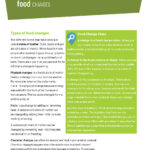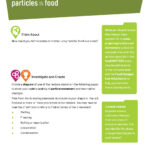What colour is milk?

 Explore the particle model of matter through food examples in FOOD CHANGES, including physical and chemical changes and the effect of heating and cooling on particle movement and speed.
Explore the particle model of matter through food examples in FOOD CHANGES, including physical and chemical changes and the effect of heating and cooling on particle movement and speed.
In PARTICLES IN FOOD, identify processes used when food is made, including melting, freezing, vaporization, evaporation and condensation and watch the concept of particle movement in action with a milk experiment.
food changes
Foods go through different types of changes. Sometimes, these changes occur when you prepare or cook food. Other times, these changes occur naturally. This is an example of a physical change and it changes the state of matter of the food.
Think about ice cream. If the ice cream melts, it changes from a solid to a liquid. Its state of matter has changed. However, it is still ice cream. When you mix fruit into yogurt, you might change its colour. However, the yogurt is still yogurt and the fruit is still fruit.
Next, think about a banana. As it ripens, it also changes colour. However, more than the colour changes. The banana gets softer and its sugar content changes. Ripening fruit is an example of a chemical change.
what happens when chicken is cooked
This chicken dish involves physical and chemical changes.
Chicken contains fat, which is solid when it is at room temperature or in the fridge. When the chicken is cooked, the fat melts – it changes from a solid to a liquid.
Chicken also contains water. As the chicken cooks, some of this water evaporates – it changes from a liquid to a gas.
The protein in the chicken changes when it is cooked. The heat from cooking changes their shape and texture. This affects the texture of the chicken.
As the chicken is cooked, the natural sugars and amino acids in the chicken go through a change called the Maillard reaction. This reaction causes the chicken to brown and new flavours to form. The Maillard reaction also happens when you make toast, roast vegetables, bake cookies and even make chocolate!
![]() Which of these changes are physical changes – changes in state of matter?
Which of these changes are physical changes – changes in state of matter?
what can happen in a glass of milk
Someone has left a glass of milk out for a few days and it has separated and smells. There are curds or solid chunks in the milk. Could this be cheese?
It’s definitely not! What has happened in this glass of milk is a process called curdling.
The process of curdling all comes down to science. Milk is made up of bunch of different things including fat, protein and sugar, and even has good bacteria in it. Curdling happens when a few of those things interact in the milk.
Here’s what happens:
- The bacteria starts to get old. If the milk was left in warm place, it increases the speed of this process.
- That bacteria starts to eat the sugar in the milk. This produces something called lactic acid.
- The lactic acid causes the protein to clump together.
- Separation of the liquids and solids occurs. The curdled milk or the lumpy proteins, separate from the liquid, into a solid called whey.
- The production of the lactic acid is also the reason for the smell.
So no, that’s not cheese forming. It’s the protein in the milk floating on the whey, so please do not try to consume it.
However, cheese does get its start in a similar way. A bacteria culture is added to milk, but not the same bacteria you would find in the glass of milk left overnight at home. The bacteria culture causes the solids to separate from the whey. Different processes are then used to make different types of cheese.
![]() What effect do temperature changes have on the particles in milk?
What effect do temperature changes have on the particles in milk?
what happens when you boil an egg
Do you know how to hard boil an egg? It might seem like a simple food to prepare, but there is actually a lot happening.
When water is boiled for the eggs, the water particles gain energy and start moving faster. The water particles near the surface of the egg also gain enough energy to penetrate the eggshell through its tiny pores.
Inside the egg, the heat causes the proteins in the egg white and yolk to denature and trap the water particles. This prevents the particles from moving freely, which turns the egg white and yolk into a solid substance.
The heat also causes the air inside the egg to expand, creating pressure that pushes against the eggshell and makes it easier to peel.
Once the egg is cooled in cold water, the denatured proteins stay solid, giving the boiled egg its firm texture.
![]() What effect do temperature changes have on the particles in the egg?
What effect do temperature changes have on the particles in the egg?
DID YOU KNOW that some people think the end of the egg should be pricked before it is boiled?
When you hard cook an egg, this air heats up, expands, and escapes through pores in the shell—but not before the egg white sets. This leaves the egg with a flattened end. Pricking the egg provides a quick escape route for the air, which gives you an egg with a smoothly rounded end. If you prick an egg, watch for a jet of air shooting from the hole as the egg cooks.
what happens when pinto beans are soaked
Apply your understanding of particle movement to create a model that shows a change of state when pinto beans are soaked to prepare them for cooking.
When the pinto beans are dry, the particles inside them are closely packed together and don’t move much.
As water is poured over the pinto beans, the water particles start to seep into the pinto beans and surround the particles inside them.
![]() Draw or show a picture of water particles surrounding the particles of the pinto beans.
Draw or show a picture of water particles surrounding the particles of the pinto beans.
The pinto beans absorb the water and become swollen and softer. The particles inside the beans are now surrounded by water particles, and they start to move around more.





